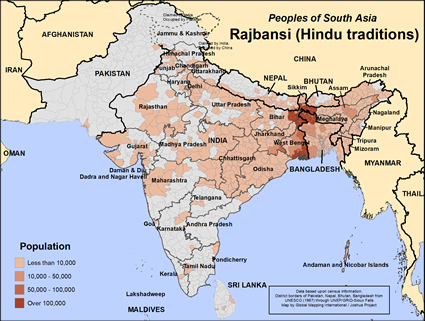Rajbansi (Hindu traditions) in India

Photo Source:
Copyrighted © 2026
International Mission Board-SBC All rights reserved. Used with permission |

Map Source:
People Group Location: Omid. Other geography / data: GMI. Map Design: Joshua Project
|
| People Name: | Rajbansi (Hindu traditions) |
| Country: | India |
| 10/40 Window: | Yes |
| Population: | 7,012,000 |
| World Population: | 8,768,000 |
| Primary Language: | Bengali |
| Primary Religion: | Hinduism |
| Christian Adherents: | 0.47 % |
| Evangelicals: | 0.00 % |
| Scripture: | Complete Bible |
| Ministry Resources: | Yes |
| Jesus Film: | Yes |
| Audio Recordings: | Yes |
| People Cluster: | South Asia Dalit - Rajbansi |
| Affinity Bloc: | South Asian Peoples |
| Progress Level: |
|
Introduction / History
The Rajbansi are an agricultural, indigenous people who live in India and Bangladesh. Smaller groups of Rajbansi live in Nepal and Bhutan. The Rajbansi claim to be descendants of the kings of the Koch Dynasty that ruled Bengali lands in the 16th century.
What Are Their Lives Like?
The primary languages of the Rajbansi are Bengali, Rangpuri and Hindi. Many of the Rajbansi are unable to read and write. Their culture is passed on by oral tradition using songs, dances, music and poetry. Some Rajbansi have attended universities and become leading politicians and athletes. Most Rajbansi still live in rural villages surrounded by their farmland. Each family owns its small plot of land. Wet rice is the leading crop followed by vegetables, maize, potatoes, and wheat. Families also raise goats, chickens, sheep, and pigs for food and to sell. Fish also makes up a big part of their diet. As Hindus the Rajbansi do not eat beef. Men and women have separate roles. The men cultivate the land and take care of the animals while the women have domestic responsibilities. Families arrange marriages with the group. Newly wedded couples live with or near the groom's parents. Sons inherit property. Village elders and priests perform important family ceremonies such as births, weddings and funerals. Some Rajbansi are moving to the cities in order to obtain a better education for their children and for new economic opportunities. Urban Rajbansi work in factories, construction and in the fishing trade.
What Are Their Beliefs?
The Rajbansi practice Hinduism, the ancient religion of India along with a strong element of animism. They worship and serve the gods of the Hindu pantheon. Hindus believe that by performing rituals and good works that they will attain moksha or freedom from the endless cycle of birth, death and rebirth. The Rajbansi visit Hindu shrines and offer prayers, food, flowers, and incense to their gods in hopes of gaining protection and benefits. The Rajbansi believe that spirits inhabit the objects of nature such as mountains, rivers, trees and rocks. They fear offending these spirits and perform rituals to appease them. The main yearly holidays of the Rajbansi people are Holi, the festival of colors and the start of spring, Diwali, the festival of lights, Navratri, the celebration of autumn and Rama Navami, Rama's birthday. The caste system divides Hindus into four main categories. The lowest communities are outside of the caste system. As a tribal people, the Rajbansi are assigned low status in Hindu society.
What Are Their Needs?
The Rajbansi need to learn new job skills and how to read and write. Their children need good schools in order to improve their place in Indian society. Most of all the Rajbansi must hear the life-changing message of Jesus Christ. He can free them from their fear of natural spirits and forgive their sins.
Prayer Points
Pray that Indian believers will befriend the Rajbansi and tell them about the Savior. Pray that gospel radio programs and gospel recordings will lead them to salvation. Pray for a Holy Spirit empowered disciple making movement to Christ among them. Ask God to raise up prayer teams who will begin breaking up the soil through intercession.